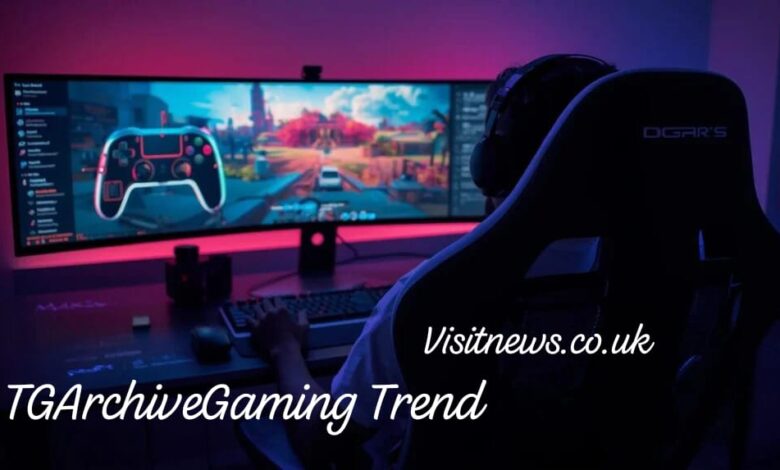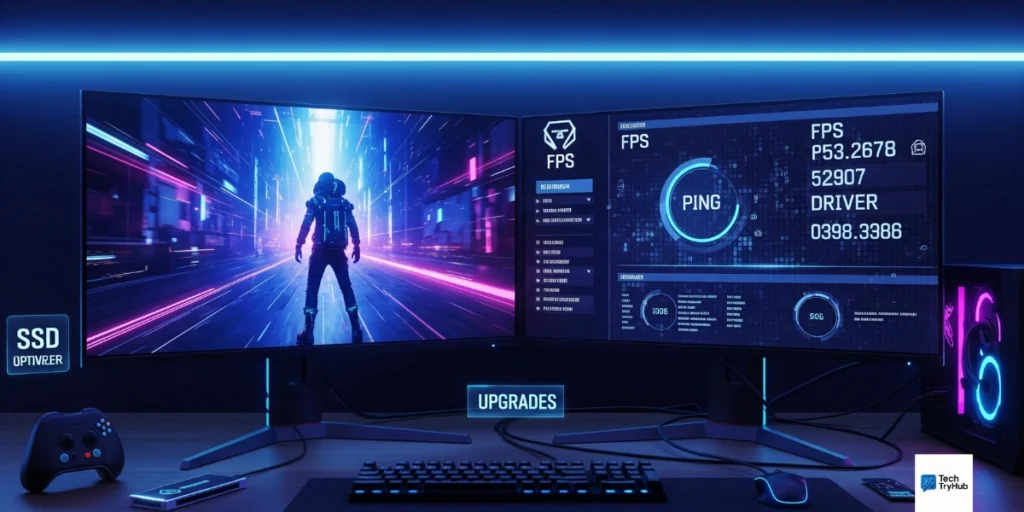The Rise of the TGArchiveGaming Trend: A Deep Dive into the New Era of Digital Nostalgia

Introduction: What Exactly Is the TGArchiveGaming Trend?
TGArchiveGaming Trend If you’ve been anywhere near gaming forums, Reddit threads, or even YouTube comment sections lately, you’ve probably come across the term TGArchiveGaming. It’s one of those trends that seems to have popped up overnight — and yet, when you look closer, it’s been quietly brewing for years.
At its core, TGArchiveGaming Trend is all about archiving, preserving, and revisiting classic gaming experiences, especially from the early internet and retro console eras. It’s where gamers come together to collect, restore, and share digital history — from old ROMs and fan mods to YouTube playthroughs and obscure game files that would otherwise vanish forever.
But TGArchiveGaming Trend isn’t just a community project. It’s becoming a cultural movement, reshaping how we think about gaming history, nostalgia, and digital preservation. The trend perfectly embodies that mix of geek passion and technological dedication that defines the gaming community.
And the best part? It’s not just about looking back — it’s also about building something timeless for the future of TGArchiveGaming Trend culture.
The Origin Story: How TGArchiveGaming Trend Became a Movement

Every major online trend has humble beginnings, and TGArchiveGaming Trend is no exception. What started as a few dedicated fans backing up old Twitch streams and emulated games slowly transformed into a massive, organized network of digital historians.
From Lost Streams to Community Archives
In the early 2020s, streamers and YouTubers began realizing that their content wasn’t as permanent as they thought. Platforms were deleting videos, copyright strikes were taking down channels, and entire TGArchiveGaming Trend moments were being wiped off the internet. Out of frustration came the idea: “What if we just saved everything?”
A few community-driven groups began backing up gameplay footage, walkthroughs, and even forum posts — not for profit, but for preservation. This was the seed that eventually sprouted into the TGArchiveGaming trend.
The Birth of the TGArchiveGaming Trend Identity
The name TGArchiveGaming Trend is believed to have originated from early Discord and Telegram groups dedicated to “The Gaming Archive.” Over time, abbreviations like “TGArchive” caught on, and the movement began to gain traction on social platforms.
Gamers began uploading entire collections of vintage content, creating centralized hubs for titles from forgotten consoles, abandoned indie projects, and even early Flash games. What started as a hobby evolved into a full-blown subculture — one driven by passion, community, and the need to keep TGArchiveGaming Trend digital heritage alive.
From Niche Hobby to Viral Trend
By 2024, TGArchiveGaming Trend wasn’t just a side project anymore. Influencers, digital historians, and even gaming journalists began highlighting the work being done by these communities. Old footage resurfaced, legendary game moments were revived, and the internet collectively realized something: gaming nostalgia has power.
The TGArchiveGaming trend became not just about saving data — but about celebrating memories.
Why the TGArchiveGaming Trend Matters Today
You might wonder, “Why all this fuss about archiving old games?” After all, with thousands of new titles releasing every year, who has time to look back? But that’s exactly where TGArchiveGaming Trend hits a nerve.
TGArchiveGaming Trend as a Cultural Artifact
Video games aren’t just entertainment — they’re art, history, and culture rolled into one. Much like how film enthusiasts preserve old cinema reels, gamers now recognize the need to protect their own digital legacy. TGArchiveGaming Trend treats games not just as files but as cultural artifacts worth safeguarding.
From the pixel-perfect charm of Super Mario Bros. to the storytelling depth of Mass Effect, each game represents a snapshot of technological progress and human creativity. Losing them would be like losing entire chapters of cultural history.
The Fragility of Digital Media
Unlike physical media like vinyl records or books, digital content is shockingly fragile. Servers shut down, licenses expire, and old hardware becomes obsolete. The TGArchiveGaming trend acts as a defense mechanism against that decay.
Gamers are now actively mirroring files, building decentralized archives, and documenting everything — from screenshots to fan translations. It’s a rebellion against digital impermanence, a way to say, “We refuse to let history be deleted.”
Nostalgia Meets Modern Tech
What really sets TGArchiveGaming Trend apart is how it bridges nostalgia with modern technology. Cloud storage, blockchain verification, and AI-driven cataloging tools are giving fans new ways to organize and preserve old data. It’s the perfect marriage of sentimentality and innovation — a mix that defines the modern internet generation.
The Community Powering the TGArchiveGaming Trend Movement
No trend survives without a passionate community, and TGArchiveGaming Trend is powered by some of the most dedicated individuals you’ll ever meet online.
The Archivists and Curators
At the heart of TGArchiveGaming Trend are the digital archivists — tech-savvy fans who spend countless hours ripping, restoring, and cataloging old files. Some specialize in lost PC games, others in ROM collections, and a few even dedicate themselves to specific consoles like the Dreamcast or PlayStation 2.
These people are the unsung heroes of the movement. They do the hard work that ensures future generations can still experience gaming’s golden eras.
The Storytellers and Streamers
Another key element of TGArchiveGaming Trend is the rise of story-driven content creators. These are YouTubers, Twitch streamers, and podcasters who don’t just play the games — they document their stories. They explore the development history, interview former developers, and highlight how certain titles shaped gaming culture.
This storytelling layer adds depth and personality to the archives. It’s not just about data; it’s about human connection and shared memories.
The Fans and Everyday Contributors
And of course, the fans themselves make up the largest part of the TGArchiveGaming Trend community. Whether it’s sharing a long-lost demo or commenting on a classic playthrough, every small contribution adds to the collective effort. The movement thrives on inclusivity — anyone can be an archivist, as long as they care about preserving the past.
How TGArchiveGaming Trend Is Shaping the Future of Gaming
Ironically, the TGArchiveGaming trend isn’t just about the past — it’s influencing the future of gaming in surprising ways.
Developers Are Taking Notes
Game developers and studios are paying attention. Many indie creators are now building games with archivability in mind — meaning easier backups, open-source versions, and long-term file support. Even big publishers are releasing digital preservation editions of classic titles to ride the nostalgia wave.
The Rise of Retro-Inspired Games
The more players revisit old classics through archives, the more they crave the simplicity and creativity of earlier gaming. That’s partly why we’ve seen a boom in pixel-art, 8-bit soundtracks, and old-school mechanics. TGArchiveGaming Trend is helping fuel this retro revival, proving that great gameplay never goes out of style.
New Standards for Digital Preservation
The TGArchiveGaming Trend movement is also setting new standards for digital preservation. Online repositories are becoming more structured, metadata tagging is getting sophisticated, and fans are adopting professional archival practices. It’s turning what used to be a hobby into something that borders on digital anthropology.
Challenges Facing the TGArchiveGaming Trend Movement
Of course, no trend is without its hurdles. TGArchiveGaming Trend faces several real-world and ethical challenges that could shape its future.
Legal Gray Areas
The biggest issue, unsurprisingly, is copyright. Many archived games are technically still under ownership, even if the companies that made them no longer exist. That puts the community in a tricky spot — wanting to preserve history without crossing legal boundaries.
Technical Limitations
Then there’s the issue of sheer data volume. We’re talking about petabytes of content — videos, ROMs, patches, and mods. Hosting and maintaining this data costs real money, and most TGArchiveGaming Trend groups rely on donations or volunteer infrastructure to keep it all alive.
Maintaining Authenticity
Finally, there’s the question of authenticity. With so many uploads floating around, verifying that a file or video is genuine becomes essential. That’s where modern tools like digital watermarking and blockchain authentication might become key players in Trend evolution.
Conclusion: TGArchiveGaming Trend — The Past, Present, and Future of Gaming Culture
The TGArchiveGaming trend is more than just a hobby; it’s a reflection of our collective desire to remember, preserve, and celebrate the history of gaming. It’s a movement that bridges generations — connecting gamers who grew up in the pixelated ’90s with those discovering retro titles today.
What started as a small community effort has blossomed into a powerful digital movement that’s reshaping how we think about media preservation. It reminds us that every game, no matter how old or obscure, holds a story worth keeping.
In a world where everything moves fast and digital content disappears with a single policy update, TGArchiveGaming Trend stands as a tribute to permanence — a digital museum curated by gamers, for gamers.
So whether you’re a nostalgic player looking to relive your favorite moments or a tech enthusiast passionate about preservation, one thing’s for sure: the TGArchiveGaming trend isn’t going anywhere. In fact, it’s just getting started.


